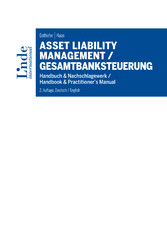Suchen und Finden
Service
Mehr zum Inhalt

Asset Liability Management / Gesamtbanksteuerung - Handbuch & Nachschlagewerk / Handbook & Practitioner's Manual
6Introduction
Asset Liability Management (ALM) means the management of the balance sheet structure with two goals:
| • | to keep risks within the limits of risk bearing capacity |
| • | to earn on the capital utilised for banking book risks |
ALM developed thanks to methodical progress based on the creation of liquid financial markets, enabling branks to bundle up risk and to transfer it into ALM without interfering with custome business.
Nonetheless important parts of bank specific risk still is not transferable via financial markets instruments mostly due to setbacks caused by the exaggerations leading to the financial crisis. Most important not/little transferable risk is credit risk and illiquidity risk. For these risk categories it is necessary to interfere with customer business in order to manage the balance sheet structure.
Since we define ALM as the management of balance sheet risk with financial instruments not all balance sheet risk can be managed by the ALM committee.
For this we require a body called “Total Bank Management committee” that manages those balance sheet risk which needs intervention into the customer businessClosely linked to Total Bank Management (TBM) is the capital management. Ultimately, theTBM is monitoring key figures that assure compliance with legal and supervisory rulings and keep the bank track due to its risk policy and strategy.
Both committees are closely linked. Whereas ALM has a focus on financial markets, TBM has a Strategy and Customer business oriented view. Therefore TBM committee members are composed out of ALM committee members and members from the business lines. Decisions will always be taken by the management board with at least one member from “markets” and one member of “non markets” being present.
This Handbook supports an active role of ALM and TBM. This means that know how is not restricted to risk management and bank regulation but also good knowledge of financial markets and its instruments is involved. This seems necessary to ensure revenue on the capital employed in balance sheet management. Without earnings on risk a bank’s business model does not seem to be sustainable.
ALM is a central banking function – although there is no common agreement on content, education standards or certificates by now. For more than 25 years Finance Trainer offers thanks to our e-learning programs and ALM simulations trainings in Asset Liability Management and Total Bank Management. Generations of bankers have gathered amazing and practically effective insights from the separation of customer margin and risk contribution in ALM.
8Based on this experience we offer an ALM certificate (Certified Asset Liability Manager/CALM) since 2010, which is used by more than 60 banks to ensure their quality standards and prove the supervisionally necessary know-how. (www.financetrainer.com/trainings)
The Asset Liability Management/Total Bank Management handbook includes the knowledge necessary for today’s practical management of the Banking Book. The 2nd edition contains primarily the additions and changes of the legal framework for ALM.
The handbook and its “worlds” are practice oriented.World 1 gives an overview on ALM/TBM including organisation, reporting and regulation. World 2 offers know how for instruments in order to manage ALM risk in a profitable way. Worlds 3–6 are focussing on the most important risk categories of ALM: interest risk, liquidity cost risk and illiquidity risk, FX risk and credit spread risk. All four “risk management Worlds” have an action oriented build up: deepened risk specific regulatory knowledge to ensure compliance, valuation curves for risk and revenue measurement, mapping the risk positions including modelling and validation requirements, specific risk measurement, management strategies and techniques and finally IFRS P&L valuation. World 7 finally focuses on Total Bank and Credit Risk Management.
The ALM/TBM handbook features the following “add ons”: chapters start indication the Learnings that can be expected and finish with an executive summary of the contents. In addition you will find wrap up questions and (at the end of the book) answers after each chapter. And most importantly: The book is bilingual – German and English, with all right pages German and all left pages English. So you can switch between the languages according to your specific needs.
More than 30 Years Finance Trainer – the book contains our experience from bank training and consulting. Generations of employees have contributed in creating the basis of this ALM/TBM handbook.
Many thanks to
| Hasan Cansü | Ina Dimitrieva |
| Martin Dostal | Heinz Hausknecht |
| Philipp Istenich | Ivan Klatev |
| Nastasja Kunz | Martin Macko |
| Sonja Mihajlovic | Hannes Mislivec |
| Alexander Möstl | Jürgen Pfeifer |
| Lisa Richter | Jakob Schlösinger |
| Hans Sebastian Schoof | Tomas Sedliacik |
| Wolfgang Wainig |
for your passion for communicating ALM/TBM and its techniques in the best way possible.
We wish you all the best!
Alle Preise verstehen sich inklusive der gesetzlichen MwSt.







